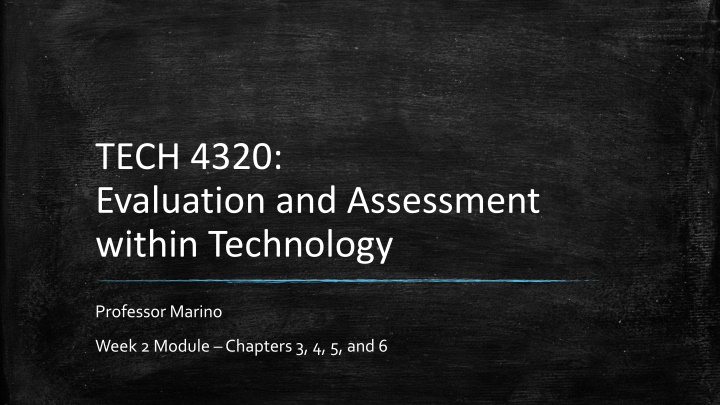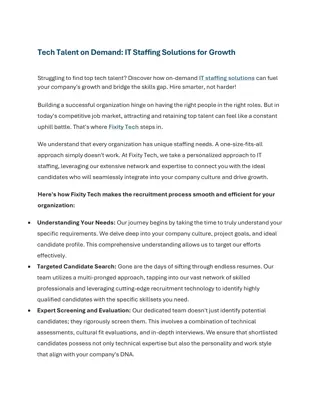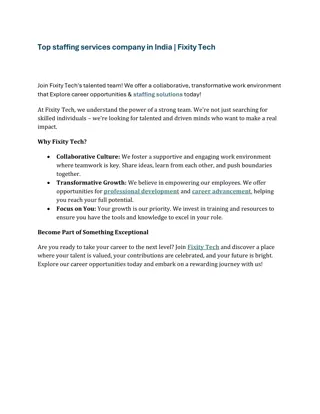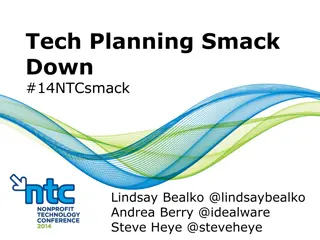
Evaluation and Assessment Models in Technology Training
Explore various evaluation and assessment models applied in technology training, including Kirkpatrick's Four-Level Model, Hamblin's Five-Level Model, Brinkerhoff's Six-Stage Model, and more. Understand the systematic factors predicting employee training outcomes and delve into models like Kaufman, Keller, and Watkins' Five-Level Model. Discover frameworks for training efficiency and effectiveness, all designed to enhance training outcomes and performance evaluation within technology education.
Download Presentation

Please find below an Image/Link to download the presentation.
The content on the website is provided AS IS for your information and personal use only. It may not be sold, licensed, or shared on other websites without obtaining consent from the author. If you encounter any issues during the download, it is possible that the publisher has removed the file from their server.
You are allowed to download the files provided on this website for personal or commercial use, subject to the condition that they are used lawfully. All files are the property of their respective owners.
The content on the website is provided AS IS for your information and personal use only. It may not be sold, licensed, or shared on other websites without obtaining consent from the author.
E N D
Presentation Transcript
TECH 4320: Evaluation and Assessment within Technology Professor Marino Week 2 Module Chapters 3, 4, 5, and 6
CH 3 Kirkpatricks Four-Level Evaluation Model https://i.ytimg.com/vi/VEb0H A4YPSk/hqdefault.jpg
CH 3 Hamblins Five-Level Model https://image.slideshare cdn.com/5- 160514155916/95/trainin g-development- assessment-methods-5- 638.jpg?cb=1463241624
CH 3 Training Effectiveness Evaluation (TEE) System https://www.re searchgate.net /profile/Rafael _Landaeta/pub lication/26216 8434/figure/tbl 2/AS:39240654 6567191@1470 568419569/mp act- assessment- model-for- training- systems.png
CH 3 Brinkerhoffs Six-Stage Model https://slideplayer.com/ slide/4152326/13/image s/8/Brinkerhoff%E2%8 0%99s+Six- Stage+Model.jpg
CH 3 Input, Process, Output Model http://www.qualified writers.co.uk/app_th emes/images/editori mages/Sol1-2017-04- 11-04-03-22.png
CH 3 Systematic Model of Factors Predicting Employee Training Outcomes https://www.researchgate.n et/profile/Andreas_Gegenfu rtner2/publication/24967388 0/figure/fig1/AS:6690827183 18608@1536533159768/An- Integrative-Model-of- Motivation-to-Transfer- Training-NOTE-Numbers- correspond-to_Q320.jpg
CH 3 Kaufman, Keller, and Watkins Five-Level Model
CH 3 Training Efficiency and Effectiveness Model (TEEM) https://www.insightsquar ed.com/wp- content/uploads/2014/03/I mage-2014-03-05-at- 3.37.27-PM.png
CH 3 Swanson and Holton Results Focus https://www.researchgate.net/ profile/Elwood_Holton/publica tion/237794157/figure/fig1/AS: 669003508903940@15365142 74766/HRD-Evaluation- Research-and-Measurement- Model-From-Holton- 1996_Q320.jpg
CH 3 Holtons HRD Evaluation Research and Measurement Model https://image.slidesharecdn.c om/returnoninvestment- 111208181442- phpapp02/95/return-on- investment-10- 728.jpg?cb=1323369591
CH 3 Success Case Method https://i.ytimg.com/v i/s- 9LruYs8xo/maxresde fault.jpg
CH 4 Politics in Evaluation Who should evaluate? Who are the major stakeholders? Who is funding the project? Who is reporting the findings? Who is implementing the evaluation process?
CH 4 Ethics in Evaluation AEA Guiding Principles - https://www.eval.org/p/cm/ld/fid=51 AEA Blog - https://aea365.org/blog/ AEA Program Evaluation Standards - https://www.eval.org/p/cm/ld/fid=103
CH 5 - Planning What is the reason for your evaluation? What is your intended purpose? pp. 146-156 provide example of planning section for Concept Paper Who are the stakeholders? What key questions are you hoping to answer? What assumptions are you making? How can you use research/literature to build a logic model for your evaluation?
CH 6 Choosing Evaluation Is your approach valid to what you re evaluating? Is your approach reliable to what you re evaluating? Will your approach produce the correct type of data? Is your evaluation choice replicable in similar settings?
CH 6 Evaluation Designs Similar to research One-Shot Design evaluation takes place at one time and one time only Retrospective Pretest Design info is collected prior to design, but also at the end as well to show if participant data has changed One-Group Pretest-Posttest Design pretest data is compared to posttest data for one group Time Series Design graphing results over a period of time to see if anything is changing through the evaluation process Pretest-Posttest Control-Group Design similar to One-Group Pretest- Posttest Design, but there are two groups [control and non-control] Solomon Four-Group Design two control groups and two non-control groups; often provides stronger data than just two groups Case Study Design examines one specific situation











